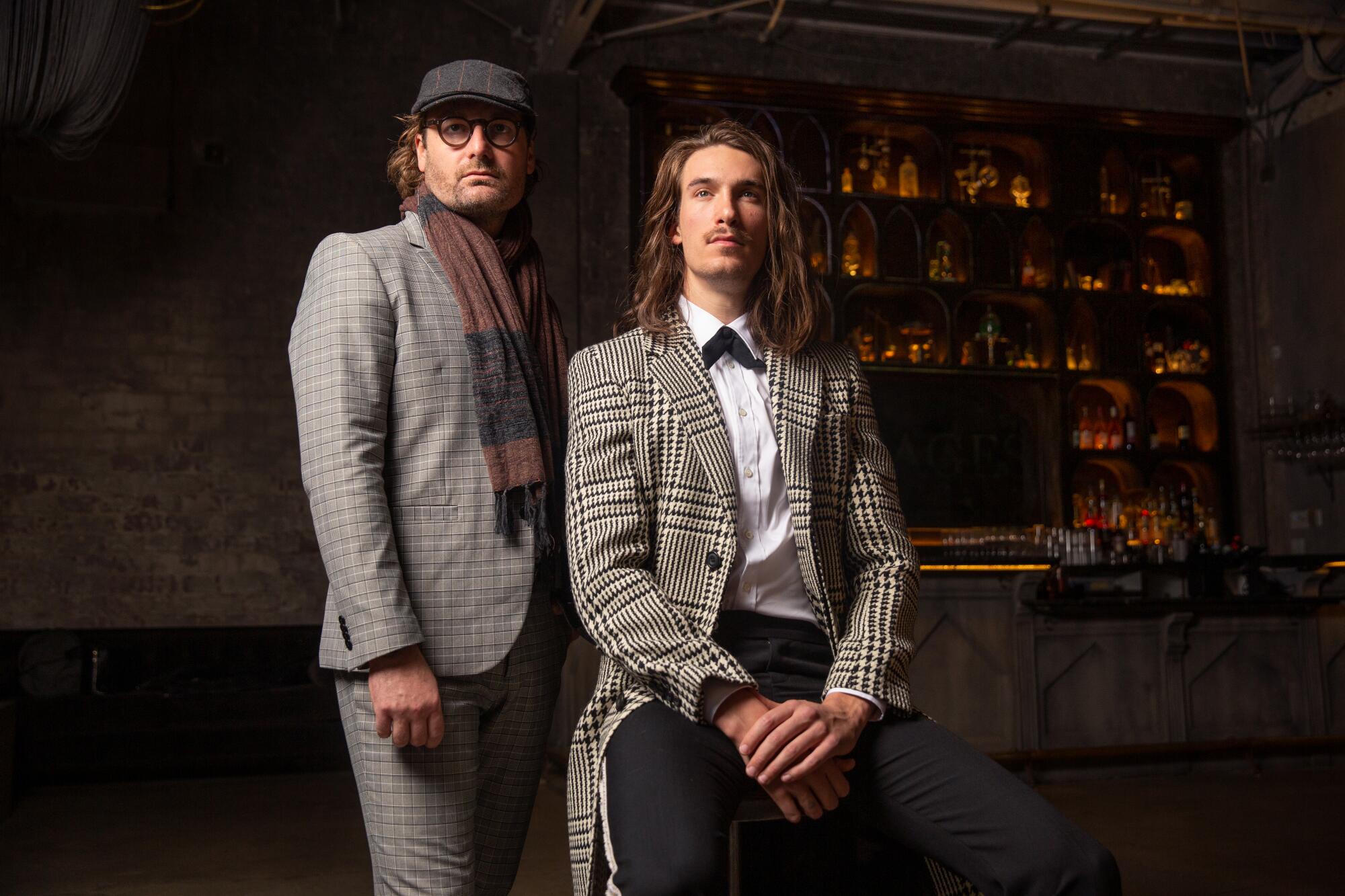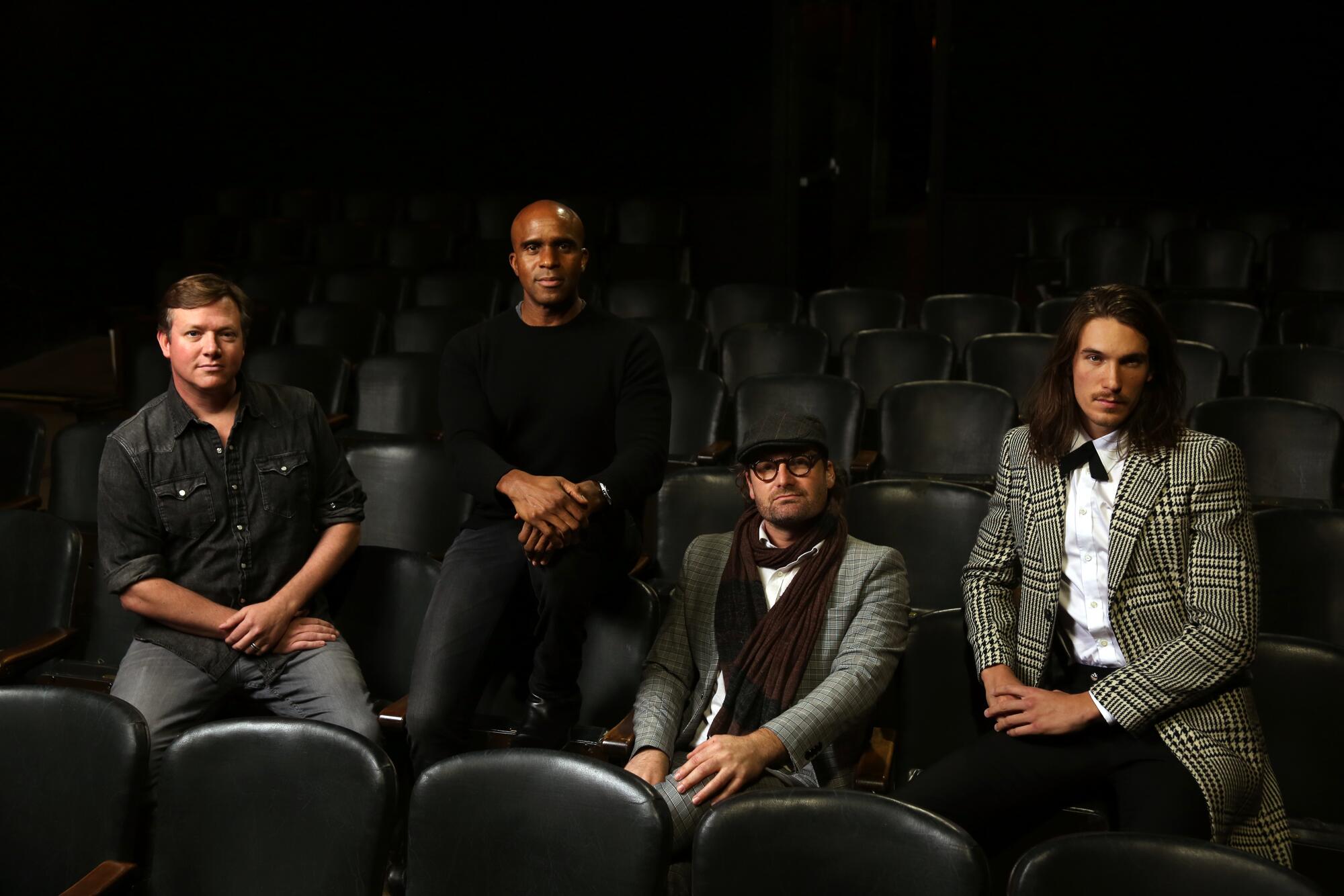
- Share via
You enter the gray, unmarked industrial building in Los Angeles’ Arts District. A dark library full of diagrams, beakers and books leads into a gothic tavern where cinephiles and monochromatically dressed hipsters are sipping pre-show cocktails.
At the appointed hour, you’re led down a hallway to a dim theater. The opening song begins, explaining that this story takes place in a dystopia where any kind of emotion is fatally forbidden. When a recluse named Woolf finds himself falling in love for the first time, he attempts to — save the world by writing a song.
Yes, you’ve heard this story before.
Or have you? The 19 songs of “Cages” don’t sound like show tunes; they have a pulsating bass, infectious hooks and a sumptuous serving of auto-tune. These earworms echo the aural aesthetics of Muse, Daft Punk, Ellie Goulding, Sufjan Stevens and Kanye West — if they were accompanied by a 50-piece orchestra.

You’ve also never seen anything quite like this. One minute you’re looking at six dancers onstage, the next minute you’re reading silent film dialogue and watching black-and-white Burtonesque animation.
Live actors and projected film mix as the man playing Woolf performs action sequences against kinetic backdrops and sings tender duets with a love interest who’s projected alongside him. Theater traditionalists, beware: That actor singing live does so with a digitized timbre, and two notable characters appear as projected apparitions.
It’s part theater, part live music video, part animated film. So, then, what is that?
“It’s a musical for people who might not like musicals,” said Benjamin Romans, who co-wrote the music and lyrics with performer CJ Baran and also is responsible for the arrangements and sound design. “Essentially, this is storytelling through modern music, and we also dress it in some pretty crazy technology.”
Producer Ian McEvily tries not to use the word “musical” in any description of “Cages.”
“We’ve been calling it ‘future theater,’ because at least there’s no negative connotations for some people,” he said. “And we really think this is what theater could look like in the future.”
For regular consumers of pop culture, this taste of “future theater” is an indulgent buffet. It doesn’t adhere to the boundaries of any particular genre or medium, and it infuses the loosest definition of a musical with the narrative languages of fantasy film and chart-topping song. The feast of sight and sound goes over best when viewers don’t try to deconstruct the recipe but rather relish the spectacle.
“People don’t have to leave their homes to be entertained anymore, so when you go out, you want to really experience something,” said producer Marc Jordan. “From the moment you enter this building and before you even get to your seat, you’re experiencing something brand new. I think anyone, even if you’re a purist, can walk away saying, ‘That was unique.’”
“Cages” came about when McEvily and Jordan, top brass at artist management firm Rebel One, paired Romans and Baran for a songwriting session. They penned tracks for Carly Rae Jepsen and Aly & AJ, but they also wrote 60 songs in an attempt to answer one question: “Can a musical sound like Bon Iver and Tame Impala and all the things that we love to listen to?”

After some well-received pop-up concerts in 2016, the multimillion-dollar endeavor kicked into high gear. Producers signed a lengthy lease for a former Amazon warehouse, which they gutted to create, film and edit all of the show’s visual content, with creative direction by David Richardson. (The music was produced in Baran and Romans’ apartments and recorded via Skype by an orchestra in Prague.) It’s since been outfitted with a top-of-the-line sound system, 1920s theater seats and a high-powered diffuser that emits a custom-made, woodsy scent.
Previews for family and friends began last fall, with no paper programs distributed and no pauses for post-song applause. Romans live-scores the show (amid projected characters’ recorded vocals) from a corner booth.
Barans plays Woolf, singing every one of his notes live while executing blocked movements onstage with remarkable precision. Because he is interacting with other characters, props and special effects projected on the screens behind and in front of him, his timing and body placement have to be perfect.
“We checked the sight lines from every single seat to make sure it would work for everyone,” Baran explained. “If I’m one inch off, oh my God, the whole show is ruined, the whole illusion is gone.”
Tickets for the open-ended run are available through March. Promotional plans parallel those of the music industry: The release of radio-ready singles and music videos are prioritized over the album. Under their Woolf and the Wondershow banner, they’ll soon sell merchandise of a certain taste, like designer candles and coffee table books. No logo-covered mugs or key chains here.
The overall vision goes well beyond Los Angeles. Because most of the show’s components are digital, operating costs are relatively low. Bar revenue augments ticket sales.
Producers hope to replicate “Cages” in other cities domestically and internationally. They also want to develop more productions specifically for their distinct amalgamation of mediums — both additional original compositions and “face-lifts” of existing intellectual property. Imagine, for example, a “Nutcracker” with projected toy soldiers and beat-driven Tchaikovsky mixes.
It’s an ambitious road ahead, but after overcoming the hurdles of opening a new production, the group sees it as full of possibilities.
“The way theater looks and sounds has been evolving since it first began, so it’s like, why can’t it evolve in this direction?” Romans said with a Woolf-like optimism. “It’s kind of an open lane for us because there’s just nothing else like this out there.”
'Cages'
Where: 1926 E. 7th Place, L.A.
When: Doors open 7 p.m. Thursdays-Saturdays (check for exceptions)
Tickets: $70-$125 (subject to change)
Info: cagesdtla.com
Running time: 2 hours (one intermission)
You always can find our latest theater news and reviews at latimes.com/theater.
More to Read
The biggest entertainment stories
Get our big stories about Hollywood, film, television, music, arts, culture and more right in your inbox as soon as they publish.
You may occasionally receive promotional content from the Los Angeles Times.











